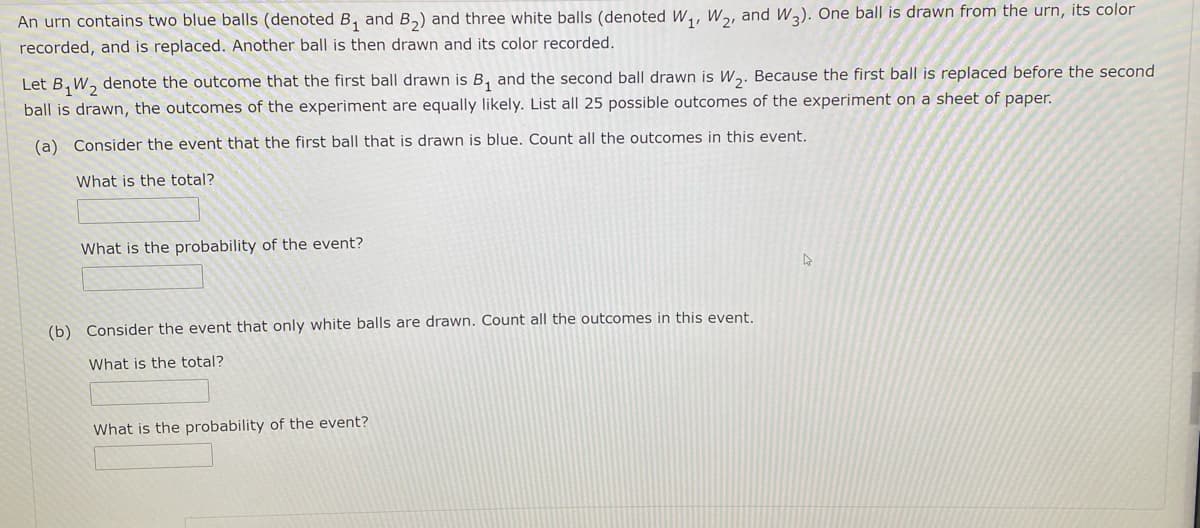An urn contains two blue balls (denoted B, and B,) and three white balls (denoted W,, W2, and W3). One ba recorded, and is replaced. Another ball is then drawn and its color recorded. Let B, W, denote the outcome that the first ball drawn is B, and the second ball drawn is W,. Because the fir ball is drawn, the outcomes of the experiment are equally likely. List all 25 possible outcomes of the experime (a) Consider the event that the first ball that is drawn is blue. Count all the outcomes in this event. What is the total? What is the probability of the event?
An urn contains two blue balls (denoted B, and B,) and three white balls (denoted W,, W2, and W3). One ba recorded, and is replaced. Another ball is then drawn and its color recorded. Let B, W, denote the outcome that the first ball drawn is B, and the second ball drawn is W,. Because the fir ball is drawn, the outcomes of the experiment are equally likely. List all 25 possible outcomes of the experime (a) Consider the event that the first ball that is drawn is blue. Count all the outcomes in this event. What is the total? What is the probability of the event?
Linear Algebra: A Modern Introduction
4th Edition
ISBN:9781285463247
Author:David Poole
Publisher:David Poole
Chapter2: Systems Of Linear Equations
Section2.4: Applications
Problem 1EQ: 1. Suppose that, in Example 2.27, 400 units of food A, 600 units of B, and 600 units of C are placed...
Related questions
Question
Please help me with this thses two problems?

Transcribed Image Text:An urn contains two blue balls (denoted B, and B,) and three white balls (denoted W,, W,, and W2). One ball is drawn from the urn, its color
recorded, and is replaced. Another ball is then drawn and its color recorded.
Let B, W, denote the outcome that the first ball drawn is B, and the second ball drawn is W,. Because the first ball is replaced before the second
ball is drawn, the outcomes of the experiment are equally likely. List all 25 possible outcomes of the experiment on a sheet of paper.
(a) Consider the event that the first ball that is drawn is blue. Count all the outcomes in this event.
What is the total?
What is the probability of the event?
(b) Consider the event that only white balls are drawn. Count all the outcomes in this event.
What is the total?
What is the probability of the event?
![Suppose A[1], A[2], A[3], . .., A[n] is a one-dimensional array and n > 50.
(a) How many elements are in the array?
(b) How many elements are in the following subarray?
A[4], A[5], ..., A[33]
(c) If 3 s m sn, what is the probability that a randomly chosen array element is in the following subarray?
A[3], A[4], . .., A[m]
(d) What is the probability that a randomly chosen array element is in the subarray shown below if n = 57?
A[[n/2]], A[[n/2] + 1], ..., A[n]](/v2/_next/image?url=https%3A%2F%2Fcontent.bartleby.com%2Fqna-images%2Fquestion%2F715dbd18-64e1-4b89-9668-473868b6f787%2F053823aa-800e-46c4-8490-211d18501b3f%2Fsaky6rb_processed.jpeg&w=3840&q=75)
Transcribed Image Text:Suppose A[1], A[2], A[3], . .., A[n] is a one-dimensional array and n > 50.
(a) How many elements are in the array?
(b) How many elements are in the following subarray?
A[4], A[5], ..., A[33]
(c) If 3 s m sn, what is the probability that a randomly chosen array element is in the following subarray?
A[3], A[4], . .., A[m]
(d) What is the probability that a randomly chosen array element is in the subarray shown below if n = 57?
A[[n/2]], A[[n/2] + 1], ..., A[n]
Expert Solution
This question has been solved!
Explore an expertly crafted, step-by-step solution for a thorough understanding of key concepts.
This is a popular solution!
Trending now
This is a popular solution!
Step by step
Solved in 2 steps

Recommended textbooks for you

Linear Algebra: A Modern Introduction
Algebra
ISBN:
9781285463247
Author:
David Poole
Publisher:
Cengage Learning

Linear Algebra: A Modern Introduction
Algebra
ISBN:
9781285463247
Author:
David Poole
Publisher:
Cengage Learning